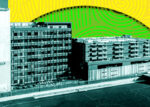
SF’s Breed and Peskin launch plan to ease office-housing conversions
Trending
 “Multifamily is in the crosshairs”: Execs talk distress, opportunities at Milken conference
“Multifamily is in the crosshairs”: Execs talk distress, opportunities at Milken conference "Financially devastating": Receiver takes over embattled Pembroke Pines condo complex
"Financially devastating": Receiver takes over embattled Pembroke Pines condo complex Blackstone sells huge industrial portfolio in NYC, New Jersey
Blackstone sells huge industrial portfolio in NYC, New Jersey Goldman Sachs and Ballast ready to surrender SF apartments to lender
Goldman Sachs and Ballast ready to surrender SF apartments to lenderMore than 10K residences could replace SF’s empty office towers
Report estimates number of housing conversions in the Financial District

San Francisco’s Financial District could have 11,200 residents waking up for a slice of toast where thousands of office desks now lie empty.
Policy research group SPUR and the local chapter of the Urban Land Institute have determined more than 10,000 housing units could be created from the neighborhood’s older office buildings — but only if the city lowers fees and affordable housing requirements, the San Francisco Chronicle reported.
An executive summary of a study expected this spring comes as City Hall and business groups hammer out policy proposals on how to reposition office towers that might be obsolete during the era of remote work.
“We want to inform policy sooner rather than later,” Sujata Srivastava, head of SPUR’s San Francisco office, told the Chronicle. “Everyone understands that downtown is in distress. This is a different moment, and we’re in a different reality.”
SPUR and ULI researchers found the most promising candidates for office-to-housing conversions are high-rises where the upper floors are no more than 20,000 square feet.
There should be ample elevators not too far from the outer windows. And there also should be a good mix of views.
By those standards, if 40 percent of the vacant space within northeast San Francisco was turned into housing, 11,200 units could be created. The study assumes that the average apartment would be 650 square feet.
But it also assumes that such conversions would pencil out for developers — and that is unlikely given that San Francisco rents have fallen during the pandemic while construction costs have climbed. The city’s development fees are among the highest in the nation.
“Everyone gets a little bit of shock when they look at the costs involved,” Srivastava said.
To counteract this, the upcoming plan recommends how the city might better prime the pump:
- Elected officials could remove or reduce the fees tied to the requirement that new housing Downtown must provide 75 square feet of outdoor space for each residential unit. That standard would be a deal-breaker since office towers sit within what already is “a highly dense urban environment,” according to the report.
- The city could waive rules that 21.5 percent of new rental housing must be reserved for lower-income residents. One reason, suggests the report, is that office towers since 1980 already have been required to pay linkage fees to help build affordable housing.
- The permit process for office building conversions could be loosened by exempting such projects from environmental reviews. This is reasonable, the summary argues, since office conversions “involve existing buildings and require no new construction of transit, infrastructure or other public facilities.”
Architecture firm Gensler and the real estate consulting firm HR&A Advisors collaborated on the report.
Some changes may already be in the works.
Mayor London Breed and Supervisor Aaron Peskin just proposed a zoning update that would loosen a rule that all multifamily projects include a sizable number of two- and three-bedroom units. It also would allow housing above the first floor of retail buildings in Union Square.
The cumulative impact of small changes could be substantial, suggests developer Eric Tao, a managing partner at L37 Partners, based in San Francisco.
Read more

Group i wants to convert historic SF offices into apartments
“We need to put these (changes) in place so that things can happen,” said Tao, chair of the San Francisco chapter of the Urban Land Institute.
At the same time, Tao cautioned that City Hall’s support won’t be enough to spark a wave of conversions.
“It takes a lot of capital” to remake a structure designed for offices, not apartments, Tao said. “The housing market isn’t promising enough right now to lure people to take a risk.”
— Dana Bartholomew

